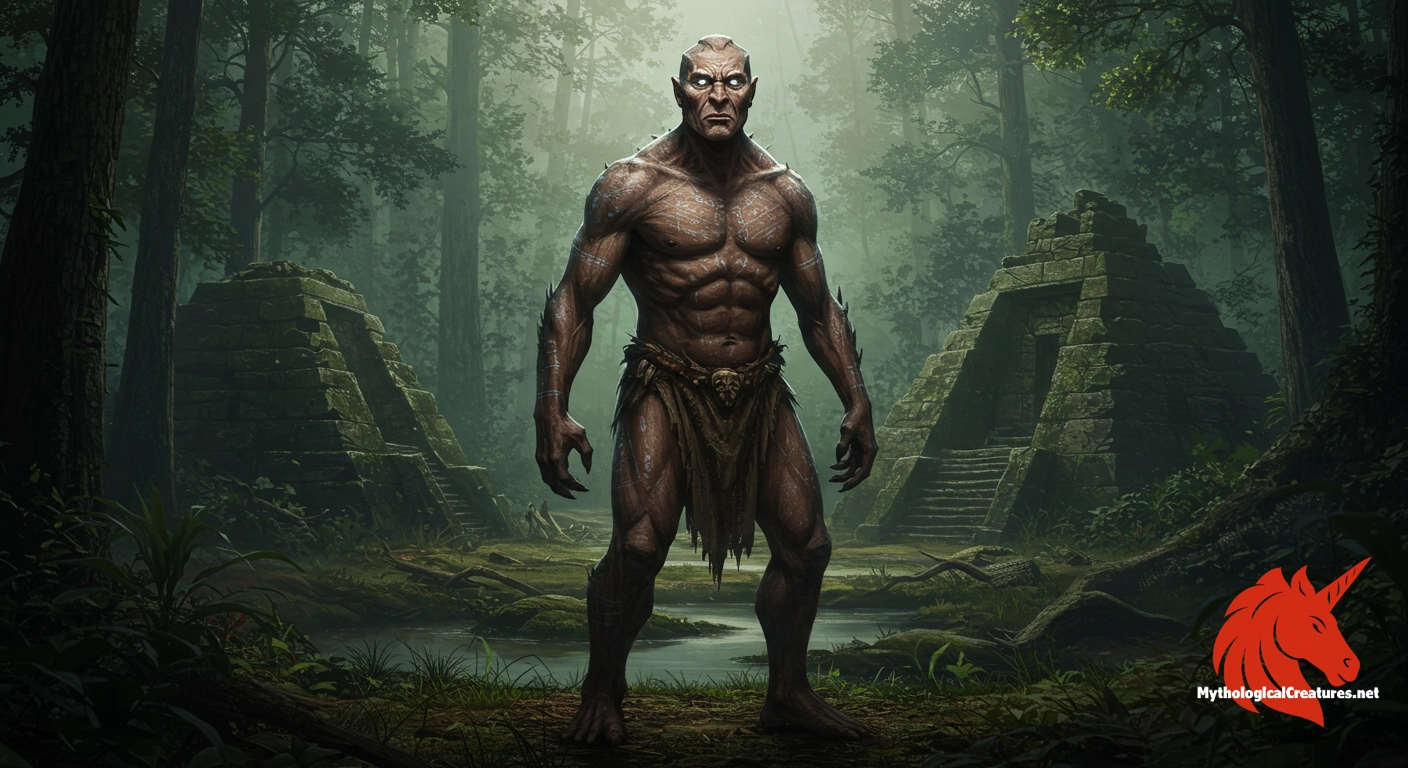Okeus: Okeus is a wrathful Native American deity revered by the Powhatan and Monocan tribes of Virginia.

Okeus
Okeus - Okeus was the most important deity in the Powhatan pantheon, whose wrath ensured cosmic balance through the infliction of calamities if not appeased.
Origins & First Encounters
Okeus, a formidable deity of the Powhatan and Monocan tribes, embodies a dual essence of both protection and severe retribution. Emerging from a rich oral tradition in Virginia, this wrathful god was revered as the guardian of communal well‐being and a punisher of transgressions. He served as a counterbalance to the war deity Ahone, his presence a stark reminder of nature’s unpredictable fury when balance was disturbed. His worship was deeply interwoven with daily life, with indigenous communities invoking his power to secure rain, cure disease, and protect harvests. Rituals dedicated to Okeus were meticulously observed to prevent calamities such as crop failure and widespread illness. Early European chroniclers, including John Smith, misinterpreted his fearsome attributes and mistakenly equated his nature with that of the devil. Temples known as Quioccosan were established as centres for ritual propitiation and communal healing. The enduring legacy of his worship highlights a dynamic interaction between fear, reverence, and the natural cycles that shaped Powhatan spirituality.
Source Texts & Tale Variants
Narratives of Okeus have been preserved through a blend of indigenous oral traditions and early European accounts. Early colonial records, notably those penned by explorers like John Smith, provide snapshots of his worship though filtered through a foreign perspective. Such texts, while limited in cultural nuance, contributed to the erroneous portrayal of his character. In contrast, the oral histories maintained by the Powhatan and Monocan people offer a more intricate and respectful depiction of his dual nature. Folkloric recounting of elaborate rites and sacrificial ceremonies underscores the depth of his influence. Archaeological findings, including artefacts and temple remnants, further attest to the sophisticated ritual practices centred on his veneration. These diverse sources collectively weave a narrative that captures both his benevolent guardianship and his formidable capacity to unleash divine wrath. The convergence of historical documentation and living tradition continues to enrich our understanding of his significance in native spirituality.
Form & Powers
Although Okeus is primarily revered as a spiritual force rather than a tangible being, artistic depictions offer valuable insights into his intended presence. Surviving effigies, such as the one discovered in Orange County, Virginia, depict him with an imposing and resolute visage that exudes authority. The facial features rendered in these artworks suggest a countenance marked by intense emotion and the stern expression of divine retribution. Traditional representations often incorporated symbolic motifs, including elaborate headdresses and natural iconography, to convey his connection with elemental forces. The carved contours and expressive eyes in these effigies imply a forceful blend of anger and protection. Although variations exist among regional depictions, recurring visual elements underscore his association with natural disasters and cosmic order. Even in the absence of a fixed iconography, the artistic legacy of Okeus communicates his towering presence and formidable character. These visual interpretations bridge the gap between abstract myth and the tangible expression of cultural identity.
Regional Faces
Regional interpretations of Okeus reflect the diverse spiritual landscapes of the Powhatan and Monocan peoples. Within the Powhatan tradition, his persona is intensely linked to the well‐being of the community, where his displeasure could usher in misfortune and natural calamities. Among neighbouring Monocan narratives, traces of additional attributes emerge, with some local renditions imbuing him with an aspect of renewal alongside his wrathful disposition. Distinct ritual practices and ceremonial observances were tailored to meet the environmental and social needs of each tribe. These local adaptations influenced the specific offerings and rites designed to appease him, reinforcing his relevance to daily life and communal balance. The underlying regional differences highlight a broader cultural sensitivity to the ways in which divine forces were experienced and understood. Such variations ensured that while his core identity remained recognisable, his character was also molded by local traditions and ecological realities. Through these regional lenses, Okeus evolved into a multifaceted deity whose worship was as dynamic and varied as the communities that honoured him.
Cultural Parallels
Okeus’s portrayal as a wrathful yet protective deity finds intriguing parallels across various mythological traditions. His dual capacity to bestow blessings and exact punishment resonates with similar archetypes found in ancient Greek and Celtic legends, where gods wielded nature’s fury to maintain cosmic balance. Like certain deities in Mesoamerican traditions, his veneration involved elaborate rituals intended to mollify his more destructive impulses. This interplay between benevolence and retribution is a recurring theme across many indigenous cultures, highlighting a universal response to the forces of nature. European colonists’ misinterpretation of his character echoes a broader pattern where indigenous gods were often reframed within the Christian dichotomy of good versus evil. In this way, Okeus serves as a compelling example of how cultural encounters can distort, yet also preserve, the underlying truths of a society’s spiritual beliefs. Comparative analysis with figures such as the Slavic Chernobog further emphasises the common human endeavour to encapsulate both order and chaos within a single divine persona. These cross-cultural connections underscore the timeless and widespread significance of deities who guard the precipice between creation and destruction.
Legacy & Modern Evolution
Over the centuries, the legacy of Okeus has undergone significant reinterpretation, reflecting shifts in both indigenous and external perspectives. Early European descriptions contributed to a pejorative reimagining of his nature, labelling him as a devil rather than recognising his complex dualism. In modern times, Native American scholars and cultural custodians have sought to reclaim his original significance, emphasising his role as a guardian deity integral to Powhatan spirituality. Recent archaeological discoveries and renewed interest in indigenous art have spurred a reinterpretation of his iconography, highlighting his associations with both protective power and necessary retribution. Contemporary artists are reimagining Okeus by blending age-old symbolism with modern aesthetics to express themes of resilience and renewal. This creative resurgence has empowered communities to reconnect with an ancestral spirituality that respects the balance between fear and reverence. Today, his image is revitalised in cultural narratives that celebrate indigenous heritage while challenging outdated colonial portrayals. Okeus now stands as a potent symbol of historical continuity and spiritual complexity, inspiring both scholarly inquiry and communal pride.
Interesting Fact
Okeus was mistakenly labelled as the devil by European colonists, which underscores the profound misinterpretations of Native American spirituality during early colonization.
Quick Creature Info
Origin:
Features:
Our Mythic Legendary Rating:

Also Sometimes Known As:
Habitat:
Supernatural Powers:
Physical Attributes:
Abilities:
Behavior:
Weaknesses:
Lore:
Related Creatures, Tales or Lore
- AAhone
- SSatan
- SSet
References
Discover Another Mythical Legend You May Not Have Heard Of?
Uncover the mysteries of ancient folklore and expand your knowledge of legendary beings from cultures around the world.
Dare to Meet the Bake-kujira....
Curated by the Mythological Creatures Team (rev. May 2025)
